Andy Lloyd's Dark Star Blog

Blog 25 (April 2015)
The Curious
Waters of Mars
When Kerry Cassidy of Project Camelot
interviewed me last month, she asked me about the
isotopic ratio of water on Mars. Why is this
seemingly small detail important to the question of
Earth's origins, you might ask? I had been
discussing how the water on Earth shares a similar
isotopic signature to that of water analysed on bodies
in the outer asteroid belt. Quixotically, it does
not share the same signature with that of most comets,
which raises serious questions about the format of the
early solar system. Essentially, things seem to
have been shaken up from how they first started.
This might offer some evidence to suggest that the Earth
began its life in the zone now occupied by the asteroid
belt, between Mars and Jupiter. So you can see why
the question of water on Mars came to mind during that
discussion - at the time I did not have an answer.
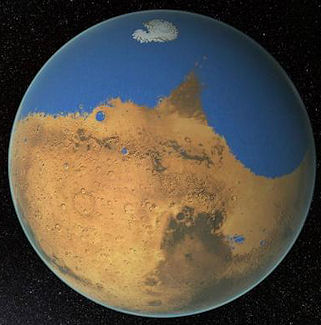
Artist’s conception of water on ancient Mars. Image
credit: NASA’s Goddard Space Flight Center
Recently, news has emerged of the
discovery of liquid water on the surface of the red
planet (1). Up until very recently, the suggestion
that liquid water could exist on the surface of Mars was
dismissed as ridiculous by scientists: The climate was
too cold and arid, and the atmospheric pressure too low
to provide the right environmental conditions to allow
liquid water to exist. Yet, satellite surveys of
the planet have provided strong evidence for the
movement of water across the Martian terrain (2) and
rounded pebbles have been found in dry river beds,
implying erosion by the flow of river water over long
time periods (3). The Martian climate may
fluctuate wildly over time due to the high variation in
the obliquity Mars' axis, and orbital parameters (2).
Although Mars might seem settled and rather dull at the
present time, it may simply be enduring a glacial
period. But, despite how cold it currently is, the
presence of liquid water appears to be just surface
deep:
"The latest
findings suggest that Martian soil is damp with liquid
brine, due to the presence of a salt that significantly
lowers the freezing point of water. When mixed with
calcium perchlorate liquid water can exist down to
around -70C, and the salt also soaks up water vapour
from the atmosphere. New measurements [by Nasa’s Curiosity rover]
from the Gale crater show that during winter nights
until just after sunrise, temperatures and humidity
levels are just right for liquid brine to form."
(1)
Okay, so this new finding shows that
liquid water can indeed exist on the surface of Mars,
but only in the form of salty brines that percolate down
through the soil. The presence of caustic
perchlorate salts in the Martian soil attracts water
from the atmosphere, particularly during the cold winter
nights, and allows water to remain unfrozen, by
significantly lowering its freezing point, rather than
becoming the previously expected permafrost.
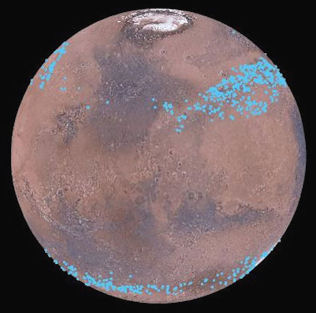
The distribution of known glaciers across
the Martian surface
Image credit: Mars Digital Image Model, NASA/Nanna
Karlsson
If liquid water can exist in the Martian
soil in the equatorial Gale Crater, where the Curiosity
rover made these findings, then it can exist most
anywhere across the planet:
"Below 15cm,
the subsurface conditions are compatible with the
existence of permanently hydrated perchlorates, which,
owing to the low mean temperature and the small diurnal
and seasonal variations, are stable throughout the day
and during all of the seasons at Gale crater.
We...expect the upper layer of the ground to be drier
in the daytime than the perenially hydrated lower
layer."
"This
detection at the equator (the driest and warmest region
of the planet) of environmental conditions that can
allow for transiently stable liquid brines defines a
threshold condition for their presence. As perchlorates
are widely distributed on the surface of Mars, this
discovery implies that the rest of the planet should
possess even more abundant brines owing to the expected
greater atmospheric water content and lover
temperatures." (4)
So much for the arid desert we were
all promised. Now, the Nasa rovers are equipped with
mass spectrometer and other bits of neat kit to allow
them to do chemistry in situ. Byt taking samples
and roasting them at various temperatures, then
analysing the resultant gases, scientists can work out
the composition of the soil. They can also work
out the isotopic ratio of Martian water, i.e. the ratio
between H2O and D2O, which varies from planet to planet.
Analysis of some Martian soil has provided the following
generalised data:
"Samples
from the Rocknest aeolian deposit were heated to ~835°C
under helium flow and evolved gases analyzed by
Curiosity’s Sample Analysis at Mars instrument suite.
H2O, SO2, CO2, and O2 were the major gases released.
Water abundance (1.5 to 3 weight percent) and release
temperature suggest that H2O is bound within an
amorphous component of the sample. Decomposition of
fine-grained Fe or Mg carbonate is the likely source of
much of the evolved CO2. Evolved O2 is coincident with
the release of Cl, suggesting that oxygen is produced
from thermal decomposition of an oxychloride compound.
Elevated
ΔD
values are consistent with recent atmospheric exchange.
Carbon isotopes indicate multiple carbon sources in the
fines. Several simple organic compounds were detected,
but they are not definitively Martian in origin." (5)
Broken down further, we obtain the Hydrogen-Deuterium
isotopic ratio:
"Hydrogen in
all Rocknest samples is highly enriched in deuterium
compared to terrestrial materials ... In addition, the
Rocknest ΔD
values are within the range of values observed by
remote-sensing analysis of the Martian atmosphere where
telescopic measurements from Earth have previously
suggested a reservoir enriched in D by a factor of ~5
over terrestrial values." (5)
It is clear from this that the
Deuterium levels on Mars are much greater than those on
Earth, by a factor of 5. I find this curious.
Why would the Earth have more in common with the
asteroids in the outer asteroid belt than Mars, which is
so much closer to us?
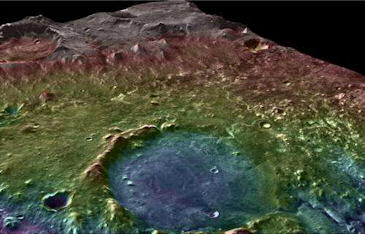
Mars's Jezero Crater was home to an
ancient lake system.
The
region around Jezero hosted at least two separate
episodes of water activity.
Image
credit: NASA/MSSS/ASU/GSFC
If the asteroids, Mars and Earth all
had similar isotopic ratios of water, then that might be
explainable as a generalised property of planets forming
in the inner solar system. But, instead, there is
significant variation, and not in the orderly manner one
might expect. Perhaps I'm wrong in my underlying
assumptions, but I understood that water (as a volatile)
is driven away by the action of the early Sun's heat and
radiation as the planets form (in much the same way as
the comets out-gas huge amounts of volatiles when
approaching perihelion). D2O
is heavier than H2O, so D2O
should survive this early onslaught better than H2O.
Therefore, the more water is driven off, the more the
isotopic ratio of water should increasingly favour the
minority deuterium
isotope of hydrogen in what remains. Assuming the extant water on
a planet's surface is the remnant of what remains of a
planet's primordial waters
(and
the substantial addition of comet water is now in doubt
(6)), then the D/H ratio should be greater for planets
closer to the Sun. So...why does Mars have such a
richer vein of deuterium both in its atmosphere and in
its soil? It almost seems like Mars should have
been closer to the Sun than Earth in the early days of
the solar system...
A reasonable counterpoint might
centre around how unprotected Mars is from the action of
the solar wind, despite its greater distance from the
Sun: It lacks the protection afforded to Earth by
its substantive magnetic field. Even so, this does
not explain why there is such a good correlation between
the Earth and the outer belt asteroids.
Furthermore, it's now becoming clear that not only is
there water on Mars, but there's actually likely to be a
great deal of water on Mars. Far from being driven
off due to the red planet's current thready atmosphere
and dismal magnetic field, the water's still there!
On top of the voluminous water ice
bound up in the two ice caps (7), new studies of the
literally thousands of glaciers known to exist across
the Martian surface have shown that these icy aqueous
reservoirs alone hold enough to cover the entire surface
a meter deep in water (8,9). That these non-polar
rich deposits of water have not been lost over time is
remarkable, and thought to be due to a protective
covering of dust. Yet, the case for repeated
episodes of water flow across the Martian landscape is
firming up, with the discovery and subsequent
geophysical study of an ancient lake system in the
vicinity of the Jezero Crater (10). It's becoming
increasingly clear that the movement of Martian water is
episodic:
"...the
difference in fan deposit mineralogy is a function of
the areal exposure of the major geomorphic units within
their watersheds. This indicates that the spectrally
dominant aqueous alteration minerals in the fan deposits
are primarily detrital, or transported, in nature and
did not form in situ. We conclude that the aqueous
alteration of the units in the watershed occurred prior
to the fluvial activity that carved the valleys of the
Jezero crater paleolake system, and that the two periods
of aqueous activity are not genetically related."
(11)
So, on the one hand we have the
need for the water reservoirs (in the form of
glaciers and generalised sub-surface salty brines) to be
protected from exposure and thus loss from the
planet; and on the other hand we have clear evidence of
episodic water flows across the landscape, and a chaotic
climate model linked to extreme variations in axial
obliquity and orbit. These do not sit together
well. Science has changed its tune dramatically in
recent years as the evidence for hidden Martian water
has emerged, which is to be welcomed. But, like
with many of the other anomalies in the solar system, it
still cannot piece the puzzle together as to what really
happened during the early solar system.
It is
clear to me that major catastrophism played a role
common to the Earth, asteroid belt and, consequently,
Mars. As a result, the cards in the solar system's
deck were reshuffled. The isotopic ratios of water
across the solar system provide us with an important
clue to piecing the whole thing back together.
Written by Andy Lloyd, 17th April 2015
References:
1) Hannah
Devlin "Nasa's Curiosity rover finds water below
surface of Mars" 13 April 2015
theguardian.com article
2) Andy Lloyd "The
Implications of Mars' Chaotic Tilt" 22 March 2015
Dark Star Blog 24
3) Andy Lloyd "A
Martian Riddle" 22 September 2014
Dark Star Blog 18
4) F. Javier Martin-Torres
et al. "Transient Liquid Water and Water Activity at Gale
Crater on Mars", Nature Geoscience Letters,
8: 357–361, 13 April
2015,
nature.com articles
5) L. Leshin, et al. "Volatile, isotope
and organic analysis of Martian fines with the Mars
Curiosity Rover", Science, 341: 6153, 2013)
nasa.gov file
6) Andy Lloyd "The
Asteroid/Comet Identity Crisis" 20 December 2014
Dark Star Blog
21
7) "Martian polar ice caps"
wikipedia.org/wiki/Martian_polar_ice_caps
8) Niels Bohr Institute,
University of Copenhagen "Satellite Observations Reveal
Glaciers of Frozen Water on Mars", 8 April 2015,
with thanks to Mark
scitechdaily.com article
9) N. B. Karlsson,
et al.,
“Volume of Martian mid-latitude glaciers from radar
observations and ice-flow modelling,” Geophysical
Research Letters, 42: 8, 28 April 2015
onlinelibrary.wiley.com abstract
10) Kevin Stacey
"Ancient Martian lake system records two water-related
events", 25 May 2015,
with thanks to Lee
phys.org news
11) T. Goudge et al. "Assessing
the Mineralogy of the Watershed and Fan Deposits of the Jezero Crater Paleolake System, Mars", Journal of Geophysical Research,
120: 4, April 2015
onlinelibrary.wiley.com article
A Star made of Dark Matter?
The concept of the Electric Universe has been around
for a while, and has some strong proponents. Because the Dark Star
Theory can sit quite happily within the constraints of mainstream
physics, I have not felt the need to explore this kind of exotic model
of physics, but I have always maintained an open mind about such
matters. Recently, I have written on the blog about how it is that
there is so much indirect evidence for this dark star object in the
outer solar system, yet little in the way of direct observational
evidence. Does this imply that this object posses
ses
exotic properties after all?
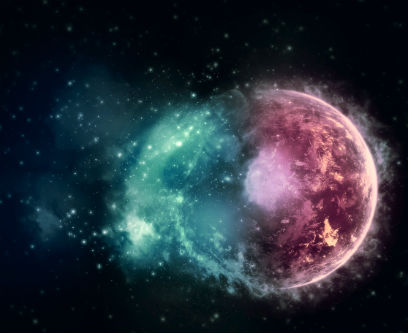
Add to this a novel definition of a proposed inbound
'Black Star' body put forward by Terral Croft, which is thought to
currently lie in the constellation Virgo and which will sweep past the
Earth, he says, on 20th May 2016 (2):
"We are
dealing with the collapsed binary twin to our Sun that is something
between a black dwarf and neutron-type star that releases no light in
the visible or infrared spectrum". (3)
He and I agree to differ on the plausibility of this
object's physical make-up. Partly, this has to do with
nomenclature, and Terral's choice of the term 'black dwarf', which is
more generally defined thus:
"A black
dwarf is a white dwarf that has sufficiently cooled that it no longer
emits significant heat or light. Because the time required for a white
dwarf to reach this state is calculated to be longer than the
current age of the universe (13.8 billion years), no black dwarfs are
expected to exist in the universe yet, and the temperature of the
coolest white dwarfs is one observational limit on the age of the
universe." (4)
But there are also issues with the second aspect of
this hybrid object - a powerful neutron star.
On the face of it,
some kind of ultra-dense, small and dark object would fit the bill
for the kind of exotic rogue object we both seek.
A hybrid
neutron-star like object which would have strong gravitational
capabilities to affect other solar system bodies, and significant
magnetic properties, too.
If it's
dark,
it might successfully
evade
direct detection in standard telescopes, but
its million degree heat (the temperature of a 'cool' neutron star) would
easily show up in
IR surveys (like WISE and IRAS).
Such an extremely dense 'star' would
also
be a highly energetic object.
It would be likely to emit significant streams of all
kinds of high energy radiation; like X-rays and microwaves, and possibly
even gamma-ray bursts.
Given that astronomers scan the skies in these
frequencies too, then such an object would stand out as a strong anomaly
in the local cosmic environment.
In that important respect, the Black Star idea creates
a detection issue that is far worse than the problems attached to a mere
sub-brown dwarf.
Nonetheless, Terral might be onto something when he
discusses an ultra-compact cosmic body which can simultaneously account
for the indirect perturbing effects upon the rest of the solar system,
whilst remaining unseen. Might such an object be made of the kind
of exotic matter which we suspect exists, but has not yet been observed
(reflecting the same issue as the Dark Star itself)?
Consider the following email I received recently:
Dear Dr. (sic)
A. Lloyd,
My name is Vladimir Netchitailo. I am a
Doctor of Sciences in Laser Physics, specializing in interaction of
laser radiation with matter. I belong to the school of physicists
established by Alexander Prokhorov – Nobel Prize Laureate in Physics and
co-inventor of masers and lasers. I have developed a model I dubbed the
World – Universe Model (WUM) that attempts to explain the World from its
creation on, both on micro and macro scale.
The proposed 4-D Model provides a
mathematical framework based on a few basic assumptions, that allows to
calculate the primary parameters of the World (its size, age,
temperature of the cosmic microwave background radiation, masses of
neutrinos and dark matter particles, etc.), in good agreement with the
most recent measurements and observations.
With the great interest I read your "Dark
Star Blog". In my Model all macroobjects of the World (galaxy clusters,
galaxies, star clusters, stars, planets) have cores made up of Dark
Matter particles which are really Dark Stars.
I would greatly appreciate any feedback you
might have on my Model, published on viXra
(5)
Thank you,
Vladimir Netchitailo
(6)
Dr Netchitailo's paper is certainly a fascinating
read, despite, I warn you, being liberally sprinkled with equations.
His is a far-ranging cosmological theory. Among many other things,
he uses his theory to explain the Pioneer anomaly - an intriguing effect
whereby both of the Pioneer spacecraft began to slow down unexpectedly
as they careered away from the solar system. The main focus of his
theory is on 'macro-objects', like Active Galactic Nuclei, and how they
might be composed of exotic materials:
"The mass of an Active
Galactic Nuclei [AGN] is about 7-11 orders of magnitude larger than the
mass of the Sun. The radius of an AGN is about 4-7 orders of magnitude
larger than the radius of White Dwarf Shell [WDS]. The area of the
closed spherical surface around the AGN is 8-14 orders of magnitude
greater than the surface area of WDS. Luminosity of the AGN is then 8-14
orders of magnitude higher than the luminosity of the Sun. This take on
an AGN explains the fact that the most luminous quasars radiate at a
rate that can exceed the output of average galaxies, equivalent to two
trillion (2×1012) suns.
"To summarize, macroobjects
of the World have cores made up of DM particles. The cores are
surrounded by shells made up of Dark Matter (DM) and baryonic matter.
Every macroobject consists of all particles under consideration that are
present in the same proportion as they exist in the World’s Medium. No
compact stars are made up solely of DM fermionic particles, for
instance." (5)
So, does his theory also apply to more commonplace
celestial objects, like stars? Well, yes it does, bringing forth
the 'dark star' connection:
"The first phase of stellar
evolution in the history of the World may be Dark Stars (DS), powered by
Dark Matter heating rather than fusion. Neutralinos and WIMPs, can
annihilate and provide an important heat source for the stars and
planets in the World. A Dark Star made up of heavier particles –
WIMPs and neutralinos – could in principle have a much higher density.
In order for such a star to remain stable and not exceed the nuclear
density, WIMPs and neutralinos must partake in an annihilation
interaction." (5)
Dr Netchitailo suggests that highly dense Dark
Stars might indeed exist, which are composed of a mixture of WIMPs
(Weakly Interacting Massive Particles (7)) and neutralinos. These,
he argues, combine within the Dark Star to annihilate one other, and in
so doing generate internal 'Dark Matter heating'. I asked him
whether these Dark Stars are actually dark, and he answered my question
in this way:
"In my Model there are know
(sic) Black Holes. All so named "black holes" are Dark Stars! At the
center of each galaxy is Dark Star. I've even proposed WIMP stars and
Neutralino stars which have the same mass and size as Neutron stars. Of
course, it can be a sub-brown dwarf, several Jupiter-masses in size as
you proposed. Everything depends on the shelves around cores made up of
dark matter particles." (8)
I take that as a yes. This would make a
lot of sense when one considers that 80% of the mass of the universe is
'missing', and is thought to be composed of Dark Matter. There is
some compelling evidence for the existence of WIMPs (9), so is it not
entirely possible that this missing mass is bound together in numerous
small and undetectable Dark Stars spread across the universe? Is
it possible that we have just such an object in our own neighbourhood?
Maybe. However, theoretical physicists currently think of these
particles in a similar way to cosmic rays - fast moving streams of high
energy particles which can move through matter with impunity, and are,
for all intents and purposes, invisible. Could they really be
bound into an object as prosaic as a Dark Star? This requires a
completely fresh look at the physics of the Universe - a path Dr
Netchitailo is not afraid to tread.
I guess what I like about what Dr Netchitailo is
trying to do is that the Dark Matter he's considering aggregates into
clumps, some immense and powerful, some small and mysterious.
When scientists try to discover this stuff
experimentally, they have little to go on besides a missing set of
numbers in a series of equations, and their job is to fill the gaps.
Because their mindset is particle physics, they assume that the
properties of said mysterious particles are going to be found in the
high energy end of physics - the kind of particles they look for in
their accelerators. But why should this be so? Just because our
immediate vicinity doesn't seem to have any Dark Matter objects in it
(regular observation would suggest anyway - although perhaps the realm
of the paranormal might suggest otherwise), that doesn't mean to say
that these objects are not widespread about the galaxy. This, after
all, is not antimatter we're talking about; there's no need to think
that this stuff mutually annihilates when it comes into contact with
matter. It might co-exist perfectly well with 'normal' matter, although
it might, perhaps, be repelled from regular matter to clump together
away from areas where regular matter clumps. Like oil and water;
perhaps they don't mix too well, and dark Matter is somehow rejected
from the solar system by the Sun. Maybe it's the 'interstellar fluff'
Nasa like to describe, existing beyond the heliosphere and the solar
system's plasma atmosphere within. Perhaps beyond the
heliosphere of every star is an interstellar void dominated by Dark
Matter. Perhaps these boundaries are more important than we realise?
We self-evidently can't see Dark Matter. The main
property it has that we are aware of is mass. That, for me in my
particular quest, is an exciting possibility. What the Dark Star I'm
considering has is mass, (so that it can warm orbiting planets through
tidal effects, and also perturb objects in the outer solar system) but
besides that it seems to be able to keep off the radar pretty well. In
other words, there's a common set of properties and sense of mystery
between a missing Planet X body of some size, and proposed Dark Matter
stars/planets/fluff. We can measure the mass effects of each, but not
see them. Extrapolate Dark Matter objects that might lurk around star
systems, or move through interstellar space independently, up to a
galaxy level and that might account for a great deal of missing mass,
especially if the core of galaxies themselves aren't actually black
holes, but are massive reservoirs of Dark Matter instead.
I'm not saying he's right, I'm just intrigued about
the possibility that in our assumptions that all of the bulky objects in
the universe are made up of regular matter, we might be missing a whole
additional category of (dark) objects hanging about in the blackness of
space.
Written by Andy Lloyd, 17th April 2015
References:
1) Andy Lloyd "The
Shroud Hypothesis" 12 January 2015
Dark Star Blog 22
2) Correspondence from Terral
Croft, 15 April 2015
3) Correspondence from Terral
Croft, 31 December 2014
4) "Black Dwarf
wikipedia.org wiki
5) Vladimir Netchitailo "4-D
World - Universe Model. Overview" 5 March 2015
vixra.org abstract
6) Correspondence from Dr
Vladimir Netchitailo, 3 April 2015
7) "Weakly interacting massive
particles"
wikipedia.org wiki
8) Correspondence from Dr
Vladimir Netchitailo, 4 April 2015
9) Michael Lemonick "Has the
Missing 80% of the Universe’s Mass Been Found?" 5 April 2013
time.com article
Snowball Earth
The idea of a "Snowball Earth" has
been around for a while (1,2). The idea came about
because of evidence of ancient glaciation in equatorial
regions, thus implying global glaciation. This
phenomenon was not likely to have been a single event,
either, but rather an extreme and rare, but nonetheless
periodic feature of our planet's climate. Central
for the mechanism for such an extreme form of glaciation
across the globe (naturally leading to immense
destruction of the planet's biosphere) is the amount of
carbon dioxide in the atmosphere, as well as changes to
the distribution of landmasses across the globe.
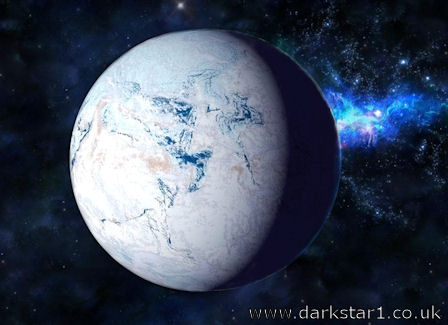
I
wrote about his back in 2002:
"But what
could account for such a fundamental climate shift that
witnessed glaciers forming over the equator? It is
thought that the break-up of the then super-continent
‘Rodinia’ may have contributed to this effect, spreading
the broken-up continents around the equator. This
increased the global ratio of sea to land and brought
about increased rainfall which, in turn, scrubbed out
the carbon dioxide from the atmosphere. A positive
feedback cycle then led to a series of glaciations
around the globe.
"But this is
not a satisfactory explanation. After all, the current
continental distribution is also located in a band
around the globe, and the last Ice Age was very mild in
comparison.... Again, I suggest that the
precondition to this series of catastrophic global
glaciations was nothing less than a temporary expansion
of Earth’s orbit. The Earth’s greater distance
from the Sun would readily explain the freezing over of
the whole planet, and the orbital expansion of Earth is
consistent with the variable activity of the Dark Star."
(3)
At that time, the concept was still
very controversial (4,5). But the evidence for
global glaciation has increased, to the point where it
is now questioned whether any oases of liquidity
remained at all during at least one of the Snowball
Earth occurrences:
"The new
data indicate Earth’s global oceans froze into a blanket
of ice and glaciers 1,000 feet thick, challenging
theories that open patches of water existed in the
equatorial regions during the first of at least two
Snowball Earth periods. “These events are
fascinating. We had times where we really had a
completely frozen Earth. If you go now to tropical
regions and you imagine thick glaciers and all the
oceans frozen, it’s crazy I think, but it appears to be
that this has happened,” geoscientist Daniel Herwartz,
with the University of Gottingen in Germany, told
Discovery News." (6)
Note how even the scientific
proponents of this theory struggle with its actual
repercussions. Yet, this is where the data directs
us. (One does wonder, in the face of this kind of
ancient natural extremity, what we get so worked up
about when discussing 2-3 degrees of man-made global
warming. It seems practically irrelevant by
comparison). I stand by my analysis of 13 years
ago: To achieve such an extreme effect by feedback
loops alone seems almost preposterous. Despite the
evidence for these events, sophisticated modelling fails
to come up with Snowball Earth effects from theory:
"There have
been difficulties in recreating a snowball Earth with
global climate models. Simple GCMs with mixed-layer
oceans can be made to freeze to the equator; a more
sophisticated model with a full dynamic ocean (though
only a primitive sea ice model) failed to form sea ice
to the equator (4)
.
In addition, the levels of CO2 necessary to melt a
global ice cover have been calculated to be 130,000 ppm,(5)
which is considered by some to be unreasonably large."
(2)
I think the Snowball Earth effect
calls for some kind of cosmic event. Some theorise
that the Earth underwent some kind of axial alteration -
perhaps a high obliquity event similar to that of Mars
(7). Changes to the Sun's output might also have
contributed. But an area that science seems less
comfortable about exploring is the potential for Earth
to have moved. While it is now commonplace
to discuss the migration of the outer gas giants, the
more tightly bound inner planets appear to be off-limits
to these kinds of migratory effects. Perhaps that
is because scientists cannot perceive of the mechanism,
or causal factor, which might bring such a transitory
migration about. It's a shame, because the
migration of the Earth away from the Sun for a period of
time would certainly help to explain the periodic
Snowball Earth effect. And the reason?
Orbital changes brought about by occasional interactions
with the rogue Dark Star during perihelion.
Written by Andy Lloyd, 17th April 2015
References:
1) P Hoffman & D Schrag
“Snowball Earth” Scientific American, Jan 2000
2) "Snowball Earth"
wikipedia.org wiki
3) Andy Lloyd "The
Cambrian Explosion and ‘Snowball Earth’" 13 June 2002
darkstar1.co.uk/extinctions.html
4) Poulsen, C.J.; Pierrehumbert,
R.T.; Jacob, R.L. "Impact of ocean dynamics on
the simulation of the Neoproterozoic snowball Earth", Geophysical Research Letters 28 (8): 1575–8,
15 April 2001
onlinelibrary.wiley.com abstract
5) Crowley, T.J.; Hyde, W.T.;
Peltier, W.R. "CO2 levels required for deglaciation
of a 'near-snowball' Earth", Geophysical Research Letters, 28 (2): 283–6,
1 January 2001
onlinelibrary.wiley.com abstract
6) Irene Klotz
"Earth Was Once a Snowball Locked in 'Crazy' Deep
Freeze" 13 April 2015,
with thanks to Lee
seeker.com article
7) Andy Lloyd "The
Implications of Mars' Chaotic Tilt" 22 March 2015
Dark Star Blog 24
A 'Black Star' Smoking Gun?
Correspondence received on
20th April 2015, from Terral BlackStar:
Hi Andy:
Thank you for
taking some time to look over the information [about the 'Black Star'
and its alleged effect on the solar system in the last few years]. The
smoking gun evidence from March 12-13, 2012 with the magnetopause
reversal and martian dust storm in combination with the Earth and Mars
position relative to the Sun in Leo seems to point to the Dark/Black
Star position moving left in the orbit diagram and in Leo at the very
same time. The evidence is more impressive once you realize March 12,
2012 is one year and one day after Fukushima representing the
Sun/Earth/Dark Star nearside-alignment quake event for the 2011 Earth
Orbit Cycle. That means Earth and Mars were making ready to pass between
the Sun and Dark Star, when magnetic portal connection convergence was
taking place between the two stars. Portal-to-portal electromagnetic
cross firing was taking place in the area of space between the Sun and
Leo, which was responsible for the Sun producing X-class solar flares.
nasa.gov news
Not only did Earth
magnetosphere turn around for 28 hours and the Martian dust storm kick
up, but the Sun was reacting to the portal-to-portal cross firing and
launching many big solar flares; as a natural defense mechanism and as
Earth was passing between the two stars. The March/September big solar
flare pattern has moved later in the year with each Earth Orbit Cycle
indicating that the Dark Star is moving in prograde fashion left in the
orbit diagram.
If you can provide
some commentary by Thursday morning Eastern Time here in the USA, then I
will post your views in the coming newsletter to be uploaded Thursday
afternoon.
Thank you again for
writing,
Terral
http://terral03.com
~~ * ~~
Hi Terral,
It's evident that there was indeed a significant
solar storm around 10th March 2011 (as per the reference you provided
(1)),but not in the timeframe that you were alluding to in your email
(you discuss March 2012?). During the March 2011 event, the Earth was
indeed bombarded with a significant Coronal Mass Ejection, causing
unusually vibrant Northern Lights, which were seen in the continental
United States well south of Alaska.

wikipedia.org
wiki/File
There was a CME
on 9th
March 2012 as well, which extended beyond Saturn:
"Enlil model for the March
2012 coronal mass ejection, plotted out to ten astronomical units
(beyond the orbit of Saturn)." (2)
However, this event did not appear to be particularly
newsworthy at the time, creating a 'moderate' G2-class
geomagnetic storm on 12th March 2012 (3), so one can assume
that it did not have a catastrophic impact on the Earth's magnetic
field. As a general point, I couldn't find any official word of a
reversal of the Earth's magnetosphere, although there are researchers
alleging that this has taken place on various websites/videos. There's
some talk about a long-term decline in the strength of the Earth's
magnetic field :
"Space agencies are now
taking the threat seriously. In November, three spacecraft were launched
as part of the SWARM mission to uncover how the Earth’s magnetic field
is changing. The mission plans to provide better maps of our planet's
magnetic field and help scientists understand the impact of space
weather on satellite communication and GPS. ‘Whilst we have a basic
understanding of the interior of the Earth, there is much we still don’t
know,’ said Dr Forsyth. ‘We do not fully understand how the Earth’s
magnetic field is generated, why it is variable and the timescales of
these variations.’"
(4)
So, such an event is not out of the question. It's
been known since the Carrington event in 1859 (5) that
a catastrophic CME could cause a significant meltdown of the Earth's
electricity networks and electronic hardware. These potential effects
were not felt in 2011, so it's fair to say that the CME in question did
not trigger as large an effect upon the Earth's magnetosphere as it is
capable of. That's not to say that the 2011 CME didn't create some
stunning effects, just not a "magnetosphere reversal". As far as I see
it, then, it doesn't seem necessary to draw a conclusion that another
cosmic body was responsible, at least on this occasion.
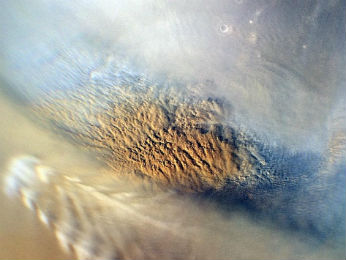
The best fit for a global dust storm on Mars that I
could find was 21st November 2012, which I guess is the one you mean.
These are periodic events, but still reasonably rare, as this November
2012 quote from Nasa makes clear:
"Regional dust storms
expanded and affected vast areas of Mars in 2001 and 2007, but not
between those years nor since 2007." (6)
So, again, this was quite a big dust storm on Mars,
worthy of note, but not so spectacular or unusual to require the need
for a cosmic cause and effect mechanism.
However, this all rather depends upon your initial
round of assumptions. If one works on the basis that a cosmic body
(black star) has indeed been moving through a perihelion passage over
the last few years, then finding a causal link between these events (as
well as the Fukishima earthquake you mentioned) and an interaction
between the Sun and the interloper makes some sense. The late John Bagby
proposed these kind of causal mechanisms many years ago (7
)
and I suspect that a stellar companion object would certainly be capable
of creating these kinds of effects, were it to be moving through the
solar system in the way you suggest. But the effects can also be
attributable to other natural effects, meaning that these events in
themselves do not provide proof of such an object's presence. I suggest,
unfortunately,
that we still lack a 'smoking gun'.
Andy Lloyd, 22nd April 2015
References:
1) Nasa "Auroras Invade the US" 10
March 2011
nasa.gov news
2) "File: The CME of March 2012.ogv"
wikipedia.org wiki/File
3) "CME Arrival from March 10th M8.4
Solar Flare" 12 March 2012
mysolaralerts.blogspot.co.uk article
4) Ellie Zolfagharifard "Forget global
warming, worry about the MAGNETOSPHERE: Earth's magnetic field is
collapsing and it could affect the climate and wipe out power grids" 31
January 2014
dailymail.co.uk article
5) "What solar flares can do - the 1859
'Carrington Event'" 7 February 2013
news.yahoo.com article
6) Nasa "Spacecraft Monitoring Martian
Dust Storm" 21 November 2012
nasa.gov news
7) Andy Lloyd "The Secrecy Surrounding the
1983 IRAS Discovery" 18 September 2014
andylloyd.org/darkstarblog18.htm
Mexican 'Nibiru' Photo
Correspondence received on 24th March 2015, from Dr R. Rodriguez:
I write again from Monterrey Mexico, not if
you remember me, I will send the pictures to your article entitled: The
Dark Star in Mexico? written by Dr. R. Rodriguez (Dr.
R. Rodríguez "¿La Estrella Oscura en México?"
darkstar1.co.uk/mexico_sp.html),
and it's been several years since then but have you news, Nibiru already
here and have proof, I sent you a picture taken from a webcam and lo and
behold there it is right in the sun, like your SABS is not visible.
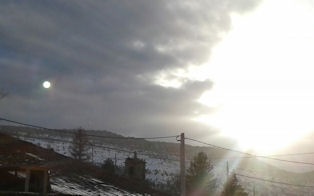
At first glance because the luminous
intensity of the sun is not possible but a camera with a special filter
if captured.
Hope you can post time is shortened.
Dr. R. Rodriguez

~~ * ~~
Hi Rene,
This one is definitely a lens flare, Rene - you can see
how is stands out against the clouds behind. But it does have something
of a luminous quality about it.
Andy
The Apocalyptic
End of Martian Civilisation?
The Daily Mail reported last month that a
physicist would be presenting his paper about the
nuclear destruction of an alien civilisation on Mars to
the 46th Lunar and Planetary Science Conference in
Houston, 16-20th March 2015:
"In November
2014, plasma physicist Dr John Brandenburg revealed his
theory that an ancient civilisation on Mars was
massacred in a nuclear attack. Now, he’s back, and
he’s going to be presenting new evidence for his theory
at a Nasa-sponsored conference today. He claims
there is no other explanation for his proposal that a
‘weapon’s signature’ remains from the attack on Mars."
(1)
It's a huge, and serious, scientific
conference, so such a sensational hypothesis would have
made quite a splash, one might imagine. Reading
the Daily Mail article, one imagines a huge hall of top
boffins restlessly listening to such a theory being
expounded, with a great deal of murmuring and tutting
from the back. One imagines a lively Q&A, with the
ensuing discussion noisily spilling over into the
restaurants and bars beyond.
One of our regular contributors
on the Dark Star Planet X forum, Gita, wondered how the
presentation had actually gone, and I duly looked up the
conference website to see.
It wasn't quite what I was expecting.
From what I can gather, Dr Brandenburg's
presentation did indeed take place. His paper (2)
is listed among the very many papers presented at the
conference, taking the form of a 'poster presentation'
in the Town Centre Exhibit Area. It was one
amongst 34 similar presentations that evening (3).
I'm sure Dr Brandenburg did a great job of getting his
ideas across to the many scientists who showed interest
in his stall, but this rather deflated what I had
(perhaps naively) imagined on the back of the Daily Mail
article.
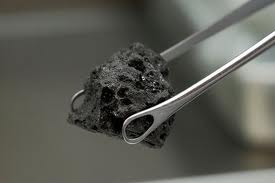
So what of his theory? Looking at anomalous
concentrations of radioactive materials across the
Martian surface, Dr Brandenburg presents three possible
alternative explanations (having excluded the
possibility of a 'natural nuclear reactor'):
"We must
consider other hypotheses that are more complex.
The first hypothesis that will be considered, is that
nuclear explosions occurred in mid-air above both Mare
Acidalium and Utopia Planum but that their cause is
anomalous, this be called (sic)
the Anomalous Explosion Hypothesis. We will also
consider the hypothesis of explosions in mid-air of two
large asteroidal bodies enriched in Iodine 129 and other
fission products and fissional materials. We will
call this the TIFRA (Tunguskoid Intrinsically -Fission
Rich Asteroid) hypothesis.
"Finally the
Null Hypothesis, will also be considered, which says
that the isotopic anomalies-particularly the xenon 129
hyper-abundance, the K-Th –U enriched surface layer, the
neutron irradiation in the Sherggotites and finally the
acid-etched glass at both the radioactive hot spots, is
simply due to variety of independent causes unique to
the large and geologically active environment of Mars
and its proximity to the asteroid belt." (2)
His ideas appear rather more sober in this extract than
in the Daily Mail article, which describes a clash of
Martian civilisations, and an existential threat posed
to us here on Earth. If I was going to put money
on one of his three suggested viable hypotheses, I'd go
for the TIFRA one. Were this to be the case, then
that puts the danger of similar asteroidal impacts
occurring here on Earth into sharp focus. A
Tunguska-type event is bad enough - but add into the mix
a widespread rain of lethal radioactive debris and one
has serious cause for concern.
Another potential
side-effect of this hypothesis is that there are
asteroid bodies out there which are rich in fissionable
materials; which is surely a major target for space
mining in the future. You would have thought that
this would have grabbed their attention...
Written by Andy Lloyd, 22nd
April 2015
~~ * ~~
Hi Andy,
I wondered too (imagination
soaring here) if the ‘weapon’s signature’ could have
resulted from Ninurta’s lot using nuclear weapons to get
at Marduk’s Mars base as well as here on Earth.
That
happened about 2024 BC according to Sitchin. Was
there any dating proposed by Brandenburg do you know?
Apparently, according to one
site I saw, some scientists reckon that the blast at
Harappa in India ...
The
Mahabharata
(4)
clearly describes a
catastrophic blast that rocked the continent:
"A single projectile charged
with all the power in the Universe…An incandescent
column of smoke and flame as bright as 10,000 suns, rose
in all its splendor…it was an unknown weapon, an iron
thunderbolt, a gigantic messenger of death which reduced
to ashes an entire race.
"
"The corpses were so burned as
to be unrecognizable. Their hair and nails fell out,
pottery broke without any apparent cause, and the birds
turned white.
"
"After a few hours,
all foodstuffs were infected. To escape from this fire,
the soldiers threw themselves into the river."
dates “back thousands of
years, from 8,000 to 12,000 years, destroying most of
the buildings and probably a half-million people.
One
researcher estimates that the nuclear bomb used was
about the size of the ones dropped on Japan in 1945.”
However, others date it (and the
one at Mahenjo Daro, further down the Indus) at about
2000 BC. All this is disputed of
course. It
would be so satisfying to have a reliable dating.
Seems that, given that the
Indus area was an Enlilite province, Enki’s lot could
have gone nuclear too.
So
it could well have extended to Mars perhaps?
Gita
(5)
References:
1) Jonathan
O'Callaghan "Were Martians wiped out by a nuclear bomb?
Physicist to present new evidence for bizarre theory at
Nasa conference" 17 March 2015,
with thanks to Lee
dailymail.co.uk article
2) J.
Brandenburg "Evidence for Large, Anomalous Nuclear
Explosions on Mars in the Past" 46th Lunar and Planetary
Science Conference, 2015
hou.usra.edu document
3) LPSC 2015
"Poster Session 1:
Geochemistry and Petrology of Martian Meteorites"
17 March 2015 6pm [T624]
hou.usra.edu document
4) Mahābhārata
veda.wikidot.com/mahabharata
5) Correspondence
received on 24 April 2015 from Gita
The Linden Tree Mural 2015
As the first of several murals for Linden Primary
School in Gloucester, I was commissioned to paint a life-size Linden
tree on the wall in their main hall in April 2015. There was a suitable
space in the hall to accommodate a tree that was about 18' high, and 15'
across - a not inconsiderable undertaking, requiring a scaffolding
platform to work from.
Because of the size of the painting, there was the
additional danger that a dark green tree would suck a lot of light out
of the room, particularly in the winter. Therefore, we agreed that the
tree would have a watermark effect to it, rather than a more realistic
range of traditional greens. The hope was that the tree would blend in
to the hall and, despite its size, remain in the background.

What made this particularly challenging for me was
that I'm not great with heights! Producing a mural of this size also
requires a fair bit of forethought - It would be difficult to mix
colours in situ, for instance, transporting pots of paint and containers
up the scaffolding. Instead, I mixed the paints (acrylic colours into
standard matt emulsion) into jam jars and painted from a fairly limited
range of colours when up high.
On the floor level, I was able to extend the range of
colours a bit, and create a more realistic field of grass along with the
tree trunk, in order to produce some depth and contrast to the mural.
The overall effect is very striking, not least because of the size of
the piece. It fits well within the space, and provides an iconic motif
for the Linden School hall without becoming overly dominant.
The Linden Tree is a fairly distinctive tree, having
a roughly conical shape and a thin trunk. This part of Gloucester had a
fair few of them at one time. It was good to be able to put one back!
Written by Andy Lloyd, 25th
April 2015
Previous Blog
Next Blog

Dark Star Blog Index
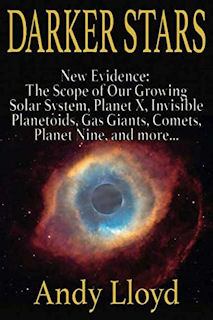
Dark Star
Books Index

You
can keep informed of updates
by following me on Twitter:
www.twitter.com/#darkstarandy

Or like my Facebook Page:
https://www.facebook.com/darkstarandylloyd















